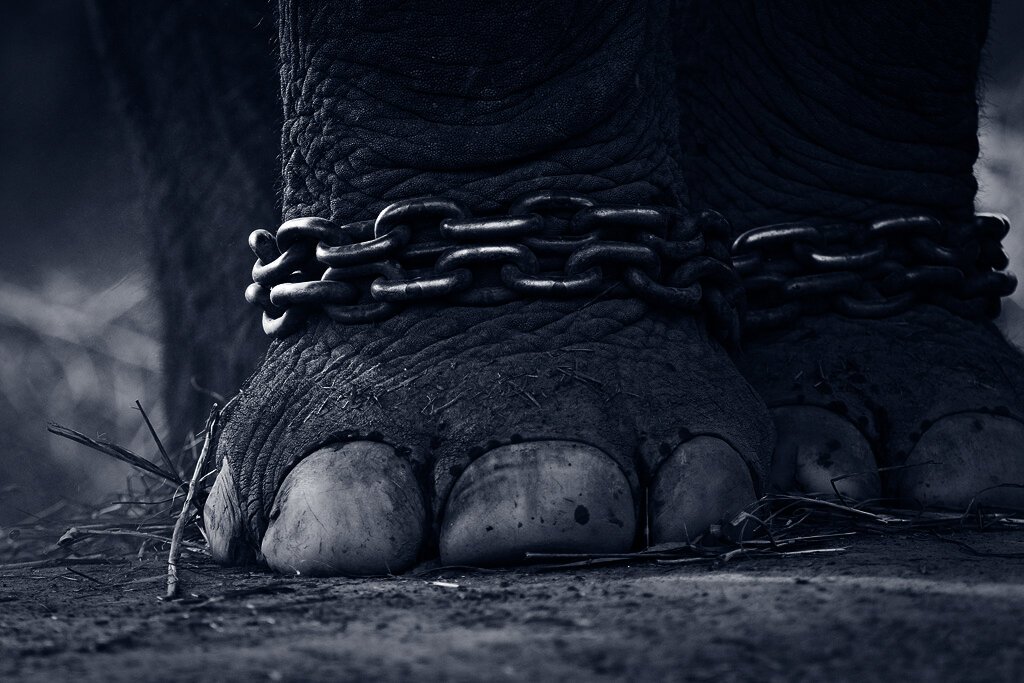The Elephant
The Myth of Helplessness - PART 1
A soft drizzle of rain falls over a muddy field. In the distance, a dozen workers in overalls unpack a train brimming with colorful panels, canvas, signage, and the bells and lights of a circus. A dozen more engage with a series of heavy ropes, working in concert to position the center pole of what will become a giant big-top tent.
Here and there, the three rings that will compartmentalize the performances stand in varied states of completion. Through the noise blares the shrill trumpeting of a circus elephant. The massive animal eclipses your line of sight. Her sheer size would terrify you, especially since she passes no more than ten yards from where you stand. But you remain at ease because her trainer seems to have her under control at the end of a rope.
In any logical scenario, this rope should not put you at ease. If that elephant were to lose her temper and decide that she would rather trample you than follow her trainer, neither her handler nor that slender piece of rope would stand a chance of stopping her.
The reason that this elephant makes no effort to resist is as sad as it is simple.
Nearby, you spot a baby elephant bound to a long stake in the ground. In stark contrast to the adult elephant’s passivity, the baby struggles ferociously against his rope. The trainer has left him alone to do this because he knows that eventually, the baby will simply give up.
This lesson will dominate the rest of the baby’s life. Eventually, even after he has fully grown into the world’s largest and most powerful land mammal, his human handler will be able to lead him around on the end of a thin rope. And it’s all because, in the mind of the elephant, he is helpless to resist.
You Have Been Similarly Conditioned
Though human beings are not bound to a stake like the elephant, the forces that seek to convince us of our own helplessness—particularly against violence—are every bit as relentless. A compelling array of cultural influences slowly and carefully conditions us to believe that the act of defending ourselves is unethical, unsafe, or even impossible.
The conditioning happens slowly and subtly.
In schools, students are told that if they stand up to a bully and fight back, they will be punished equally alongside the bully. Meet violence with self-defense, and you will be suspended or expelled. Your only choice is to run, beg an authority figure to protect you, or simply roll over and take it. This doesn’t teach young people to be kinder or more peaceful. It teaches them to be helpless. To be victims.
The notion is never more insidious than when women are taught that fighting back against sexual assault only increases the chance that they will be more seriously injured or killed. This misguided message—one based on zero evidence—is particularly damaging because it encourages women to give up on the prospect of doing the one thing that might actually save them from assault.
Many law-enforcement officers, well intentioned though they may be, perpetuate this victim mentality. “Just call 911 and let the police handle it,” indoctrinates us into the erroneous notion that citizens either shouldn’t try to protect themselves or are incapable of doing so.
In response to the drumming that violence (even in self-defense) is wrong, and that ordinary people are incapable of defending themselves, most people simply conclude—consciously or unconsciously—that they must thereby rely on others to keep them safe. That because they are helpless, their personal security is someone else’s responsibility.
The Myth of Helplessness has become as ubiquitous in our society as cancer. And much as cancer weakens and eventually destroys the body in which it inhabits, such conditioning weakens and will eventually destroy the society in which it takes hold. Over the course of this three-part series on the Myth of Helplessness, I intend to expose these realities and share my thoughts on how the only way to beat this cancer is to stand up and accept something we have given away too freely: our responsibility to protect ourselves.
This exploration will not be political in nature. It is neither right wing nor left. It is neither politically correct nor incorrect. It is not generational or gender specific. It is not pro-gun or anti-gun. It merely examines the reality that human society, just like any animal in nature that gives up its willingness and ability to protect itself, is primed for disaster. Just ask these mice.

